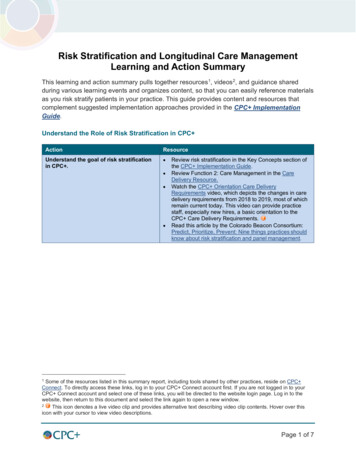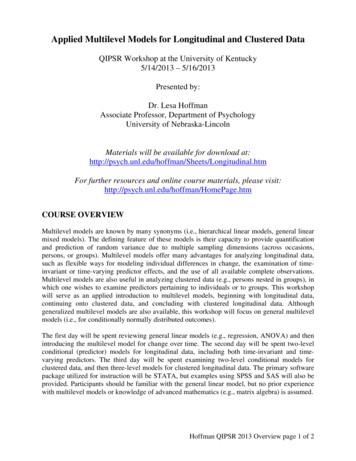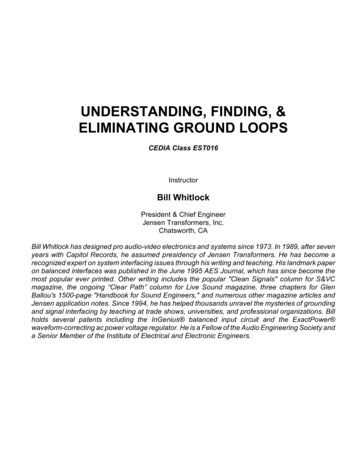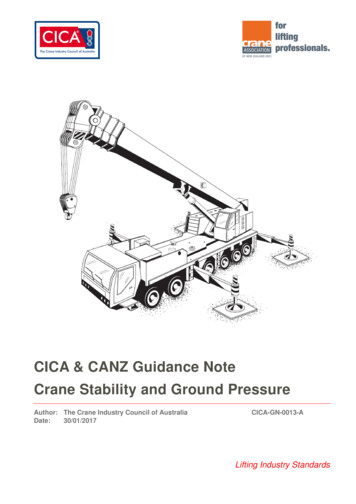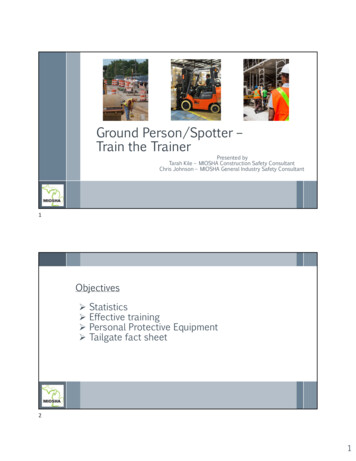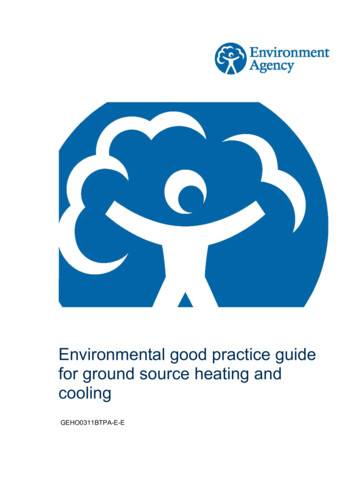
Transcription
Flightlab Ground School7. Longitudinal Dynamic StabilityCopyright Flight Emergency & Advanced Maneuvers Training, Inc. dba Flightlab, 2009. All rights reserved.For Training Purposes OnlyDynamic stability, our real subject here, refers tothe time history that transpires followingdisplacement from equilibrium, as shown inFigures 1and 2.Aircraft can either have inherent aerodynamicstability (the typical case), or de-facto stability,in which stability requirements are met with theaid of a control system augmented with sensorsand feedback. For example, in order to achievemaximum maneuverability, the F-18 lacksinherent stability, and can’t be flown withoutsome operational brainpower on board inaddition to the pilot. The Boeing 777 has relaxedinherent longitudinal static stability, whichproduces efficiencies in cruise from a morerearward c.g. and a physically lighter tailstructure than otherwise possible. Boeingtransport aircraft have conventional downwardlifting tails that, like all such tails, in effect addweight to the aircraft by virtue of the “down-lift”Figure 1Static StabilityNegative: Quick todisplace, hard to returnPositive: Quick toreturn, hard to displaceTimeTimeDisplacementAn airplane can’t be trimmed unless it haslongitudinal (around the y axis) staticstability—in other words, unless pitching forcestending to equilibrium are present. But thegreater an aircraft’s static stability (thus thegreater the forces tending to equilibrium) themore resistant the aircraft is to the displacementrequired in maneuvering. For a given aircraft, themost important factor in determininglongitudinal static stability is c.g. position.Moving the c.g. aft reduces static stability.Neutral: StaysputPositive: Slower toreturn, easier todisplaceBill Crawford: WWW.FLIGHTLAB.NETTimeNegative: Slower todisplace, easier toreturnTimeDisplacementStatic stability is an object’s initial tendencyupon displacement. An object with an initialtendency to return to equilibrium is said to havepositive static stability. For those blessed with aconventional pilot’s education, the concept ofstability normally evokes the textbook image ofa marble rolling around in something like ateacup, as shown in Figure 1.DisplacementStability is the general term for the tendency ofan object to return to equilibrium if displaced.they generate (and also drag, the by-product ofthat lift). The main wing has to produceadditional lift in compensation, and consequentlyproduces more drag itself, which costs money atthe gas truck. Moving the c.g. aft reduces thenecessary down-force. The 777’s digital flightcomputers make up for the resulting longitudinalstability deficit—but the aircraft still has to havesufficient inherent stability to be flown safelyand landed should the digital augmentation gobust. The monster Airbus A380 employs an aftcenter of gravity for the same reason. It canpump fuel aft to shift the c.g.DisplacementIntroduction to Stability7.1
Longitudinal Dynamic StabilityFigure 2Dynamic StabilityDisplacement from TrimPositive Static Stabilityand Neutral DynamicStabilityPositive Static Stabilityand Negative DynamicStabilityPositive Static Stabilityand Positive DynamicStabilityTimeFigure 3Positive DynamicStabilityPeriodFigure 3 illustrates positive longitudinal dynamicstability: a series of damped oscillations ofconstant period, or frequency, and diminishingamplitude, that bring the aircraft back to thetrimmed condition after a displacement.Period is time per cycle. Frequency, which isinversely proportional to period, is cycles perunit of time. Amplitude is the difference betweenthe crest or the trough and the originalequilibrium condition.Damping is the force that decreases theamplitude of the oscillation with each cycle. Thedamping ratio, ζ, is the time for one cycledivided by the total time it takes for theoscillation to subside. The higher the dampingratio, the more quickly the motion disappears.Damping defines much about the character of anaircraft. If damping is too high, an aircraft mayseem sluggish in response to control inputs. Ifdamping is too low, turbulence or control inputscan excite the aircraft too readily; its behaviorappears skittish.There are two modes of pitch oscillation: theheavily damped short period mode (dampingratio about 0.3 or greater), followed by the7.2DisplacementDynamic Stability: Short Period andPhugoidTime EquilibriumAmplitudeTime to subsidePeriod/Time to subside damping ratio, ζlightly damped, and more familiar, long period,phugoid mode. When you maneuver an airplanein pitch by moving the stick forward or back,you initially excite—and essentially just ridethrough—the short period mode. If you werethen to let go or to return the stick back to thetrim position, the aircraft would enter thephugoid mode. Instead, you normally hold thepressures necessary to prevent a phugoid fromoccurring.Short PeriodThe short period mode is excited by a change inangle of attack. The change could be caused by asudden gust or by a longitudinal displacement ofBill Crawford: WWW.FLIGHTLAB.NET
Longitudinal Dynamic StabilityFigure 4Short Periodα Trim αα-12Time (seconds)the stick. Figure 4 shows the variation in angle ofattack, α, over time. The aircraft quicklyovershoots and recovers its original angle ofattack, or its new angle of attack in the case of anintentional pilot input and a new stick position.The motion of the tail causes most of thedamping, although other parts of the aircraft cancontribute to damping (or to oscillation). There’snegligible change in altitude or airspeed by thetime the mode subsides. During the short periodoscillation the aircraft pitches around its c.g.Positive damping of the short period is importantbecause catastrophic flight loads could quicklybuild from a divergent oscillation—suddenly theairplane has oscillated into parts. The shortperiod mode is also an area in which pilotinduced-oscillations, PIO, can occur, because thetypical lag time in pilot response is about thesame as the mode’s period (approximately 1-2seconds). As a result, by the time a pilotresponds to an oscillation his control input is outof phase, and he ends up reinforcing rather thancounteracting the motion he’s trying to correct.At some point during our flights, we can performa frequency sweep with the stick to try to isolatethe aircraft’s short period natural frequency, ωn.(As a child you pumped a swing in rhythm withits natural frequency to make it go higher andterrify your mother.) We’ll do this by moving thestick back and forth over a constant deflectionrange of perhaps three or four inches, but fasterand faster until we find the input frequency thatplaces us 90 degrees out of phase—meaning thatthe stick is either forward or back when the noseis on the horizon (although it can be hard to tell).We’re then at the undamped short period naturalfrequency—undamped because we’re driving itwith the stick. Then we’ll abruptly return thestick to neutral when the aircraft is at its trimattitude, and observe the damping of the shortperiod oscillation. It subsides very quickly, as inFigure 4.The frequency sweep is not occupant friendly,but it’s a good way to assess an aircraft’s pitchacceleration, or “quickness.” The high pitchacceleration—the ability to quickly change angleof attack—is one of the first things you’ll noticewhen transitioning to high-performanceaerobatic aircraft. You can think of an aircraft’snatural frequency in terms of its ability to“follow orders”—how rapidly you can tell it todo one thing, then tell it the opposite, and stillhave it respond. The higher the naturalfrequency, the more response cycles you cancoax from it per unit of time. As we do oursweep, you’ll notice that past a certain point youcan’t coax any more. Then the faster you movethe controls back and forth the less the aircraftresponds. It’s as if the aircraft figures that youcan’t make up your mind, and that you need tobe ignored.An aircraft with a low natural frequency mayseem initially unresponsive to control input. Apilot may then over control, using a large initialinput to get things going, only to find that theaircraft’s final response is excessive. If thenatural frequency is too high, the aircraft willfeel too sensitive in maneuvering and tooresponsive to turbulence.Aircraft with low short period damping ratiostend to be easily excited by control inputs andturbulence, and the resulting oscillations takelonger to disappear. Aircraft with high shortperiod damping can be slow to respond—they’resluggish, and the control forces seem high.(We’ll also look at our trainer’s quickness in roll.The notion of a natural roll frequency doesn’treally apply, because an aircraft isn’t supposed tooscillate in roll. Oscillatory response ischaracteristic of “second-order” systems. Firstorder systems, like a rolling aircraft, areexponential and non-oscillatory. We’ll do some“roll sweeps,” anyway. You’ll discover a similarfall-off in response.)Bill Crawford: WWW.FLIGHTLAB.NET7.3
Longitudinal Dynamic StabilityLong Period—PhugoidThe lightly damped, long period, or phugoid,oscillation can take minutes to play out. But itdoesn’t get to very often. Unlike the short mode,the phugoid period is long enough that the pilotcan intervene easily and return the aircraft toequilibrium. We typically demonstrate thephugoid by pitching the nose up (thus excitingthe short period mode) and allowing the aircraftto decelerate and stabilize some 15-20 knotsbelow trim. Then we positively return the stickto its original trimmed position. The positivereturn overcomes any friction in the elevatorsystem, and this keeps us from imposing anoverall descent or a climb onto the phugoid.Usually it doesn’t matter if you then hold thestick or let it go, since the difference betweenstick-fixed and stick-free is minor in the longperiod mode. But for consistency in response wewant to keep the wings level. By using rudder forthat job, we can avoid inadvertent pitch inputs.(On our flights we’ll often enter a phugoid moretheatrically, perhaps as the recovery from a spiraldive.)From the nose-high attitude, the nose will beginto drop through the horizon into a descent, thenpitch up and climb back up as speed increases. Itthen repeats the cycle, overshooting its original,trimmed airspeed/altitude point by less and lesseach time. During the phugoid the aircraftmaintains essentially a constant angle of attack,α, while cyclically trading altitude and airspeed(potential and kinetic energy) until it againregains equilibrium as in (Figure 3). The pitchrate and the variation in maximum pitch attitudewill diminish with each oscillation. Pitch attitudeat the very top and bottom will be approximatelythe same as the original pitch attitude at trim.Minimum airspeed will occur at the point ofmaximum altitude, and maximum airspeed willoccur at the point of minimum altitude.The phugoid oscillation is typically damped andconvergent, but it can be neutral, or evendivergent, and the aircraft will still be flyable,because of the ease with which the pilot canbring the long period under control (you’recontrolling the phugoid whenever you holdaltitude). But poor damping does increase theworkload and complexity of the scan forinstrument pilots when flying by hand, becausethe effort needed to hold altitude increases. Poordamping also makes it harder to trim an aircraft.7.4Low speed at topFigure 5PhugoidalWingmanLead pilot’sposition andvelocityHigh speed at bottomThe undulating lines back in Figure 3 suggesthow the phugoid would appear to a stationaryobserver. Figure 5 shows the same from thepoint of view of another pilot flying level information, watching a “phugoidal”(“phugoiding?”) wingman. The aircraft appearsto rise and fall as airspeed changes produce liftchanges. Excess airspeed at the bottom produceslift greater than weight and a resulting upwardforce. Diminished airspeed at the top produceslift less than weight and a resulting downwardforce. Remember, α stays the same.As a result of the airspeed changes an aircraft inthe phugoid would also appear to move back andforth, falling behind at the top of the cycle andscooting forward at the bottom, but less and lesseach time as the motion damps out.Drag effects, rather than tail movement, dampthe phugoid. Raising parasite drag increasesdamping. With both the short period and thephugoid mode, an aft shift in c.g., close to theneutral point, will begin to produce an increasein period and a decrease in damping (for neutralpoint, see ground school “Longitudinal StaticStability”).Propellers add a damping factor absent with jets.If brake horsepower is constant, propeller thrustincreases as airspeed decreases, and vice versa.This adds a forward force at the low-speed top ofthe phugoid and a restraining force at the highspeed bottom. This changing thrust/airspeedrelationship helps reduce the speed variationfrom trim and thus helps damp the motion.Bill Crawford: WWW.FLIGHTLAB.NET
Longitudinal Dynamic StabilityThe phugoid is sensitive to coefficient of lift, CL.At slow speeds, thus at high CL, both the periodand the damping decrease. At high speeds, thusat low CL, both period and damping increase.RegulationsFAR Part 23.181(a) requires that the short periodoscillation must be “heavily damped” with thecontrol free and fixed. FAR Part 23.181(d)requires that “Any phugoid oscillation must not be so unstable as to increase the pilot’sworkload or otherwise endanger the aircraft.”Part 25.181, for large aircraft, says the samething about the short period, but leaves thephugoid unmentioned.The common element in the regulations is therecognition that a pilot can readily control thelong phugoid mode, and it’s not a crucial factorin flying qualities.In regulatory practice, “heavily damped” meansin no more than two cycles. Test pilots for theRaytheon Premier I took the aircraft to 35,000feet to evaluate short period behavior in gusts.After pitching up and releasing the controls(stick-free), they found that the aircraft tookapproximately 2.5 cycles and 5 seconds to returnto level flight. The FAA agreed that thispresented no safety issues, but refused to wavetheir criteria (2 cycles and 4 seconds). Thedesigners fixed things by adding wedges to thetrailing edge of the elevator to change the hingemoments, making the elevator’s response tovertical gusts more neutral and bringing theaircraft into line with FAA requirements. All ofthis happened after an earlier modification hadslightly reduced the friction in the elevatorcontrol system, which in turn reduced thedamping ratio. The strange protuberances yousee on aircraft often have complex histories.Bill Crawford: WWW.FLIGHTLAB.NET7.5
Longitudinal Dynamic Stability7.6Bill Crawford: WWW.FLIGHTLAB.NET
conventional pilot’s education, the concept of stability normally evokes the textbook image of a marble rolling around in something like a teacup, as shown in Figure 1. An airplane can’t be trimmed unless it has longitudinal (around the y axis) static stability—in other words, unless pi

